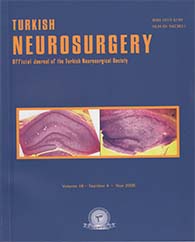MATERIAL and METHODS: 46 consecutive patients underwent operation for lateral ventricle tumors. The mean age was 36 years. Preoperative magnetic resonance imaging (MRI) images were examined to determine the location, expansion and size of each tumor. The transcallosal approach was used in 25 patients, and the transcortical approach was used in 21 patients. We performed MRI to determine the tumor size and recurrence or increased size of the residual tumor.
RESULTS: Total resection was performed in 31 patients. Only one patient, with glioblastoma, died due to hepatic encephalopathy and intraventricular hemorrhage after the operation. Additional neurological deficits were seen 4 patients, and postoperative seizure occurred in one patient. The mean duration of follow-up was 38,37 months.
CONCLUSION: Lateral ventricle tumors can be treated best by careful selection of the surgical approach according to localization of the tumor within the ventricle, the expansion side of the tumor, the size of the tumor, the origin of the vascular feeding branches, the venous drainage, and the relationship of the structures, and the histopathological features.
Keywords : Lateral ventricle neoplasm, Surgical approach, Transcallosal, Transcortical




